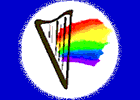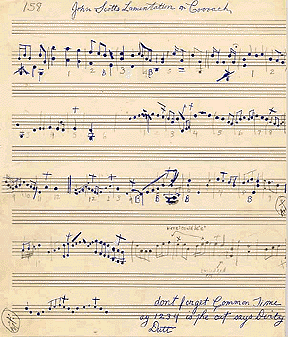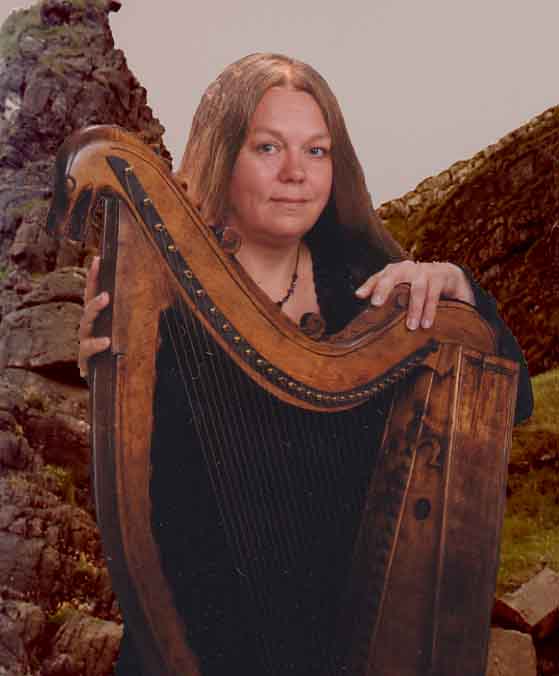














| Denis O'Hampsey, His Style and Technique by Ann Heymann Donnchadh Ó Hámsaigh (1695-1807), known in English as Denis O'Hampsey, Hampson or Hempson, was a contemporary of Irish harper Carolan, and by seventeen years the oldest harper to attend the 1792 Belfast Harp Festival. |
 Click image for more detail. |
| At ninety-two years of age, he was the only harper there who
still employed the traditional fingernail techniques that give the
Gaelic wire-strung harp its full range of expression. Edward Bunting,
who had been hired by the Festival Committee to notate the music played,
was most impressed and made several trips to O'Hampsey's cottage at
Magilligan, County Derry, to procure more music and information. In
Magilligan Denis was known as O'Hampsey and not as Hempson, so although
Edward Bunting's use of Hempson as the surname has prevailed, it lacks
authenticity and sanction and O'Hampsey is preferable. Bunting tells us that the "pieces which he [O'Hampsey] delighted to perform were unmixed with modern refinements, which he seemed studiously to avoid; confining himself chiefly to the most antiquated of those strains which have long survived the memory of their composers, and even a knowledge of the ages that produced them. Hempson was the only one of the harpers at the Belfast Meeting, in 1792, who literally played the harp with long crooked nails, as described by the old writers. In playing, he caught the string between the flesh and the nail; not like the other harpers of his day, who pulled it by the fleshy part of the finger alone. He had an admirable method of playing Staccato and Legato, in which he could run through rapid divisions in an astonishing style. His fingers lay over the strings in such a manner, that when he struck them with one finger, the other was instantly ready to stop the vibration, so that the Staccato passages were heard in full perfection...It was with the greatest difficulty [I] was able to procure the old harp music from Hempson. When asked to play the very antique tunes, he uniformly replied that there was no use in doing so, they were too hard to learn, they revived painful recollections. In short, he regarded the old music with a superstitious veneration, and thought it, in some sort, a profanation to divulge it to modern ears." At the close of the eighteenth century O'Hampsey's age and musical conservatism set him apart from the other harpers of the time. Validating his importance, he alone used the traditional fingernail technique, and he alone preserved ancient and neglected repertoire - most notably Féach an gléas and Scott's Lamentation. Bunting says that Denis never enjoyed playing the hugely popular compositions of Carolan, and they comprised less that 20% of his known repertoire. While approximately one of every two tunes reported played at the 1792 Belfast Harp Festival were Carolan's, O'Hampsey played none. |
|

|

|
|
The following titles, gleaned mostly from information contained in Bunting's manuscripts and personal effects, comprise the extent of Denis O'Hampsey's known repertoire: Lady Letitia Burke Burns' March O'Hampsey told Bunting that this tune "is one of the progressive lessons taught young harpers and is the fourth tune generally learnt." An Chúilfhionn (Coolin or Lady of the Desert) Brighid na bPéarlaidh (Bridget of the Pearls) The Darling (A Mhuirnín, literally "My Darling") Dawn of Day (Eirghe An Lae) Down Beside Me (Sin Sios Suas Liom) Eibhlín a Rúin(Eileen Aroon) The Fox's Sleep (Coladh an tSionnaigh) A chailíní, a' bhfaca sibh Seóirse (Girls, Have You Seen George or Conor Macareavy) Tá mé i mo chodhladh is ná dúisigh mé (I am asleep and don't waken me) *The Jointure John Jones *Bob Jordan Madam Keel or Eleanor Plunkett (All known sources consider these to be different pieces,but they are the same tune and the titles refer to the same person) A Lovely Lass to a Friar Came Love is a Tormenting Pain or Showers of Rain Bunting gives the perhaps conflicting evidence that O'Hampsey considered this to be Scottish and to be a William Connellan composition entitled The Golden Star. Music for The Golden Star has not been identified, and Bunting twice elsewhere confused the title with other Connellan tunes: The Jointure and Dawn of Day (both also in O'Hampsey's repertoire). On the other hand, being Scottish and associated with the Connellan harpers is not necessarily incompatible because Thomas and (possibly) his brother are known to have travelled in Scotland.Planxty Connor Kitty O'Hara Sgarúint na gCompánach (The Parting of Friends) Scott's Lamentation (Cumha an Albanaigh) Traditional instrumental and vocal Gaelic laments were normally tripartite, and this three part instrumental lament for Thomas Purcell, Baron of Loughmoe, was composed by 16th century harper John Scott from County Westmeath. According to O'Hampsey "this was one of the Old Irish Lessons for the harp" and it had been at least fifty years (before 1746) since someone asked him to play it.Maidin Bheag Aoibhinn (Soft Mild Morning) Molly St. George (Mailí San Seórse) Uilleagán Dubh O [literally "Dark Head O"] (The Song of Sorrow) Tá an samhradh ag teacht (Summer is Coming) Féach an gléas (Try If It Is In Tune) The title also was used as a term by medieval Gaelic scribes for the testing of their quill pen's trimming. Improvised instrumental preludes were performed throughout medieval Europe, and this one corresponds with the "melodic line in rambling style and free rhythm, extending over a few sustained chords" of 15th century German organ preludes.*Caitilín Triall(Kitty Tyrrel) What is That to Him The Young Man's Dream (Aisling an Óigfhir) Later variants are said to include Castlehyde, Groves of Blarney, Last Rose of Summer, Preab sa Ól and Danny Boy. *denotes titles we ascribe to O'Hampsey solely on the basis of their position in Bunting's original manuscript (MS 29). On the authority of other sources his repertoire also included: Black Headed Deary (Ceann Dubh Dilis) The King Shall Enjoy His Own Again Molly Bheag O (Little Molly O) The White Cockade Molly Stuart Hob Nob The Dying Lover "Saibha gheal ni Granda" O'Cahan's Lament Seven of these pieces (Letitia Burke, The Darling, John Jones, Eleanor Plunkett, Scott's Lamentation, Summer is Coming and Try If It Is In Tune) - three of them Carolan's - would not survive today were it not for O'Hampsey's playing them for Bunting. Another five (Bridget Cruise, The Fox's Sleep, Love is a Tormenting Pain, The Parting of Friends and What is That to Him) are the earliest recorded versions of the tune. Turlough O'Carolan is represented six times (Lady Letitia Burke, John Jones, Bob Jordan, Planxty Connor, Eleanor Plunkett and The Parting of Friends), and four are compositions by the harping brothers Thomas and William Connellan (Dawn of Day, The Jointure, Love is a Tormenting Pain and Molly St. George). Apparently Denis was fond of the variations composed by contemporary Kerry harper Cornelius Lyons, for he played at least five of them: The Coolin, Eileen Aroon, A Lovely Lass to a Friar Came, Conor Macareavy and What is That to Him. |
|
| Denis was born at Craigmore, near Garvaghin County Derry, but both his father's (Bryan Darrogher O'Hampsey) and mother's families held large land holdings in the Magilligan area 10-15 miles to the northwest, where Denis eventually settled. At age three he was blinded by smallpox and by age twelve he began to learn the harp from the first of four teachers (Bridget O'Cahan, John C. Garragher, Loughlin Fanning and Patrick Connor). |
 The author with the original Downhill Harp. Click image for more detail. |
| Six years later a Counsellor Canning in Garvagh bought him what
we know today as the Downhill harp that is owned and displayed by the
Guinness Brewery in Dublin. Denis travelled extensively throughout Ireland and Scotland, playing before Prince Charles Stuart in 1745. In his later years and until his death in 1807, Denis was patronised by Frederick Hervey, 4th Earl of Bristol and Bishop of Derry, who built the Downhill estate between Magilligan to the west and Portstewart to the east on the northern County Derry coast. Downhill overlooks the strand at the mouth of the River Bann, which is named in Gaelic mythology as the birthplace of the first harp--and O'Hampsey, the last of the traditional Gaelic harpers, was from this same region. With his death at Magilligan coincided the death of the instrument itself, in a strange way completing the tradition's cycle. O'Hampsey's legacy is not only the survival of his Downhill harp and its tuning schedule, but also knowledge of the necessary techniques, repertoire and style to allow the true voice of the Gaelic harp to be heard once again. You can hear Ann play Cumha a' Chléirich (an Irish pìobaireachd) at https://www.youtube.com/watch?v=0tT9MGhvzFU Listen to Feaghan Ghleas & Scott's Lamentation of Youth played traditionally on a replica of the Downhill harp from Ann Heymann's album Queen of Harps. https://open.spotify.com/track/361Kc7DNJ97QjvaviDPU3W
|
|

|

|
| [To author biography] | [Back to top of page] |
Historical Harp | Folk and World Harp | Pedal Harp |
Harp Building | Harp Works | Non-Harps |
Camps & Concerts | Links | Glossary |
Donate! | Get Involved! | Contact Us | About Harp Spectrum
Copyright 2002 - 2017, Harp Spectrum All Rights Reserved